Interdisciplinary Knowledge Flow in International Higher Education Research: Characteristics and Mechanisms
Abstract
:1. Introduction
2. Theoretical Framework
3. Methodology
3.1. Data Selection and Processing
3.2. Research Tools and Measurement Methods
4. Results
4.1. Knowledge Slope and Interdisciplinary Knowledge Flow in HER
4.2. Knowledge Stickiness and Interdisciplinary Knowledge Flow in HER
4.3. Medium Permeability and Interdisciplinary Knowledge Flow in HER
5. Discussion
5.1. Characterization of Interdisciplinary Knowledge Flows in HER
5.1.1. The Direction of Interdisciplinary Knowledge Flows in HER Is Knowledge-Importing
5.1.2. Interdisciplinary Knowledge Flows in HER Present Knowledge Networks of Family Resemblance
5.2. Mechanism of Interdisciplinary Knowledge Flow in HER
5.2.1. Knowledge Slopes Facilitate Interdisciplinary Knowledge Flows in HER
5.2.2. Knowledge Stickiness Hinders Interdisciplinary Knowledge Flow in HER
5.2.3. Medium Permeability Determines the Interdisciplinary Knowledge Flow in HER
6. Conclusions and Implications
7. Limitations and Future Directions
Author Contributions
Funding
Institutional Review Board Statement
Informed Consent Statement
Data Availability Statement
Conflicts of Interest
References
- Abramo, G., & D’Angelo, C. A. (2020). The domestic localization of knowledge flows as evidenced by publication citation: The case of Italy. Scientometrics, 125, 1305–1329. [Google Scholar] [CrossRef]
- Albert, M., Rowland, P., Friesen, F., & Laberge, S. (2022a). Barriers to cross-disciplinary knowledge flow: The case of medical education research. Perspectives on Medical Education, 11(3), 149–155. [Google Scholar] [CrossRef]
- Albert, M., Vuolanto, P., & Laberge, S. (2022b). Re-appraising disciplines: A commentary. Studies in Higher Education, 48, 413–423. [Google Scholar] [CrossRef]
- Anthony, B., Jr. (2020). Information flow analysis of a knowledge mapping-based system for university alumni collaboration: A practical approach. Journal of the Knowledge Economy, 12, 756–787. [Google Scholar] [CrossRef]
- Avelar, A. B., & Farina, M. C. (2022). The relationship between the incorporation of sustainability in higher education and the student’s behavior: Self-reported sustainable behavior scale. International Journal of Sustainability in Higher Education, 23(7), 1749–1767. [Google Scholar] [CrossRef]
- Bargmann, C., Thiele, L., & Kauffeld, S. (2021). Motivation matters: Predicting students’ career decidedness and intention to drop out after the first year in higher education. Higher Education, 83, 845–861. [Google Scholar] [CrossRef]
- Bess, J. L., & Clark, B. (1985). Perspectives on higher education: Eight disciplinary and comparative views. Administrative Science Quarterly, 31, 679. [Google Scholar] [CrossRef]
- Borlaug, S. B., Tellmann, S. M., & Vabø, A. (2022). Nested identities and identification in higher education institutions—The role of organizational and academic identities. Higher Education, 85, 359–377. [Google Scholar] [CrossRef]
- Cummings, J. L., & Teng, B.-S. (2003). Transferring R&D knowledge: The key factors affecting knowledge transfer success. Journal of Engineering and Technology Management, 20(1–2), 39–68. [Google Scholar] [CrossRef]
- Daugule, I., & Kapenieks, A. (2019). Knowledge flow analysis: The quantitative method for knowledge stickiness analysis in online course. Periodicals of Engineering and Natural Sciences (PEN), 7(1), 165–171. [Google Scholar] [CrossRef]
- Davenport, T. H., & Prusak, L. (2000). Working knowledge. Harvard Business Press. [Google Scholar]
- Dixon, N. M. (2000). Common knowledge: How companies thrive by sharing what they know. Harvard Business School Press. [Google Scholar]
- Flores, M. A., Barros, A., Simão, A. M., Pereira, D., Flores, P., Fernandes, E. L., Costa, L., & Ferreira, P. D. (2021). Portuguese higher education students’ adaptation to online teaching and learning in times of the COVID-19 pandemic: Personal and contextual factors. Higher Education, 83, 1389–1408. [Google Scholar] [CrossRef]
- Ghoshal, S., & Bartlett, C. A. (1988). Creation, adoption and diffusion of innovations by subsidiaries of multinational corporations. Journal of International Business Studies, 19, 365–388. [Google Scholar] [CrossRef]
- Huan, H., Yongyuan, M., Sheng, Z., & Qinchao, D. (2017). Characteristics of knowledge, people engaged in knowledge transfer and knowledge stickiness: Evidence from Chinese R&D team. Journal of Knowledge Management, 21, 1559–1579. [Google Scholar] [CrossRef]
- Jensen, M. C., & Meckling, W. H. (1992). Specific and general knowledge, and organizational structure. In L. Werin, & H. Wijkander (Eds.), Contract economics (pp. 251–274). Blackwell. [Google Scholar]
- Klein, J. T. (1990). Interdisciplinarity: Histories, theories, and methods. Wayne State University Press. [Google Scholar]
- Lakatos, I. (1978). The methodology of scientific research programmes (pp. 48–49). Cambridge University Press. [Google Scholar]
- Laurett, R., Paço, A. D., & Mainardes, E. W. (2022). Sustainability in higher education institutions: A case study of project FUCAPE 120% sustainable. International Journal of Sustainability in Higher Education, 23(7), 1604–1627. [Google Scholar] [CrossRef]
- Lewin, K. (1947). Frontiers in group dynamics: Concept, method and reality in social science; social equilibria and social change. Human Relations, 1(1), 5–41. [Google Scholar] [CrossRef]
- Leydesdorff, L., Carley, S. F., & Rafols, I. (2012). Global maps of science based on the new Web of Science categories. Scientometrics, 94, 589–593. [Google Scholar] [CrossRef]
- Liu, M., Hu, X., & Li, J. (2017a). Knowledge flow in China’s humanities and social sciences. Quality & Quantity: International Journal of Methodology, 52, 607–626. [Google Scholar] [CrossRef]
- Liu, M., Shi, D., Li, J., & Lozano, S. (2017b). Double-edged sword of interdisciplinary knowledge flow from hard sciences to humanities and social sciences: Evidence from china. PLoS ONE, 12(9), e0184977. [Google Scholar] [CrossRef]
- Lv, H., & Li, J. (2021). 1987–2016年跨学科知识流动的规律: 一个新的视角“学科势能”. [An investigation of interdisciplinary knowledge flow from 1987 to 2016: A new perspective of “disciplinary potential energy”]. 图书情报知识 [Documentation, Information & Knowledge], 38(4), 125–135. (In Chinese). [Google Scholar] [CrossRef]
- MacDonald, G. P. (2012). Theorizing university identity development: Multiple perspectives and common goals. Higher Education, 65, 153–166. [Google Scholar] [CrossRef]
- Matczak, A., Akdogan, H., & Ashmore, D. (2022). The paradox of technology in online education during the COVID-19 pandemic: The experiences of safety and security students in a Dutch university. Higher Education, 86, 1269–1292. [Google Scholar] [CrossRef]
- Menon, S., & Suresh, M. (2022). Development of assessment framework for environmental sustainability in higher education institutions. International Journal of Sustainability in Higher Education, 23(7), 1445–1468. [Google Scholar] [CrossRef]
- Mishall, P. L., Meguid, E. A., Khalil, M. K., & Lee, L. M. (2022). Transition to effective online anatomical sciences teaching and assessments in the pandemic era of COVID-19 should be evidence-based. Medical Science Educator, 32, 247–254. [Google Scholar] [CrossRef]
- Mitchell, W. J. T. (1995). Interdisciplinarity and Visual Culture. The Art Bulletin, 77(4), 540–544. [Google Scholar]
- Park, H. W., & Kang, J. (2009). Patterns of scientific and technological knowledge flows based on scientific papers and patents. Scientometrics, 81(3), 811–820. [Google Scholar] [CrossRef]
- Piaget, J. (2002). Epistemology in the human sciences (W. Zheng, Trans.). Central Compilation Publishing House. [Google Scholar]
- Porter, A. L., Cohen, A. S., Roessner, J. D., & Perreault, M. (2007). Measuring researcher interdisciplinarity. Scientometrics, 72(1), 117–147. [Google Scholar] [CrossRef]
- Porter, A. L., Roessner, D. J., & Heberger, A. E. (2008). How interdisciplinary is a given body of research? Research Evaluation, 17(4), 273–282. [Google Scholar] [CrossRef]
- Pratt, A. D. (2010). A measure of class concentration in bibliometrics. Journal of the Association for Information Science & Technology, 28(5), 285–292. [Google Scholar] [CrossRef]
- Rafols, I., & Meyer, M. (2007). How cross-disciplinary is bionanotechnology? Explorations in the specialty of molecular motors. Scientometrics, 70(3), 633–650. [Google Scholar] [CrossRef]
- Rafols, I., & Meyer, M. (2009). Diversity and network coherence as indicators of interdisciplinarity: Case studies in bionanoscience. Scientometrics, 82, 263–287. [Google Scholar] [CrossRef]
- Reed, R., & DeFillippi, R. J. (1990). Causal ambiguity, barriers to lmitiation, and sustainable competitive advantage. Academy of Management Review, 15(1), 88–102. [Google Scholar] [CrossRef]
- Rodríguez, J. M. (2017). Disciplinarity and interdisciplinarity in citation and reference dimensions: Knowledge importation and exportation taxonomy of journals. Scientometrics, 110(2), 617–642. [Google Scholar] [CrossRef]
- Simonin, B. L. (1999). Ambiguity and the process of knowledge transfer in strategic alliances. Strategic Management Journal, 20(7), 595–623. [Google Scholar] [CrossRef]
- Sorenson, O., Rivkin, J. W., & Fleming, L. (2002). Complexity, networks and knowledge flow. Strategy Unit Working Paper Series; Harvard Business School. [Google Scholar] [CrossRef]
- Szulanski, G. (1996). Exploring internal stickiness: Impediments to the transfer of best practice within the firm. Strategic Management Journal, 17(S2), 27–43. [Google Scholar] [CrossRef]
- Taşkın, N., & Kılıç Çakmak, E. (2022). Effects of gamification on behavioral and cognitive engagement of students in the online learning environment. International Journal of Human–Computer Interaction, 39(17), 3334–3345. [Google Scholar] [CrossRef]
- Teichler, U., & Sadlak, J. (2000). Higher education research: Its relationship to policy and practice. IAU Press. [Google Scholar]
- Truc, A., Santerre, O., Gingras, Y., & Claveau, F. (2023). The interdisciplinarity of economics. Cambridge Journal of Economics, 47(6), 1057–1086. [Google Scholar] [CrossRef]
- UNESCO. (2021). UNESCO Recommendation on open science. United Nations Educational, Scientific and Cultural Organization. [Google Scholar]
- Urata, H. (1990). Information flows among academic disciplines in Japan. Scientometrics, 18(3), 309–319. [Google Scholar] [CrossRef]
- Von Hippel, E. (1994). Sticky information and the locus of problem solving: Implications for innovation. Management Science, 40, 429–439. [Google Scholar] [CrossRef]
- Wagner, C. S., Roessner, J. D., Bobb, K., Klein, J. T., Boyack, K. W., Keyton, J., Rafols, I., & Börner, K. (2011). Approaches to understanding and measuring interdisciplinary scientific research (IDR): A review of the literature. Journal of Informetrics, 5(1), 14–26. [Google Scholar] [CrossRef]
- Wittgenstein, L. (1953). Philosophical investigations. Blackwell. [Google Scholar]
- Wang, X. (2010). Higher education as a field of study in china: Defining knowledge and curriculum structure. Routledge Falmer. [Google Scholar]
- Wang, Y., Hu, R., & Liu, M. (2017). The geotemporal demographics of academic journals from 1950 to 2013 according to Ulrich’s database. Journal of Informetrics, 11(3), 655–671. [Google Scholar] [CrossRef]
- Whitaker, S. (1986). Flow in porous media I: A theoretical derivation of Darcy’s law. Transport in Porous Media, 1, 3–25. [Google Scholar] [CrossRef]
- Yang, J., & Liu, Z. (2022). The effect of citation behaviour on knowledge diffusion and intellectual structure. Journal of Informetrics, 16(1), 101225. [Google Scholar] [CrossRef]
- Yue, Z. H., & Xu, H. Y. (2019). 学科引证网络知识扩散特征研究 [Characteristics of knowledge diffusion in disciplinary citation network]. 情报学报 [Journal of the China Society for Scientific and Technical Information], 38(1), 1–12. (In Chinese). [Google Scholar] [CrossRef]
- Zaballos, A., Briones, A., Massa, A., Centelles, P., & Caballero, V. (2020). A smart campus’ digital twin for sustainable comfort monitoring. Sustainability, 12(21), 9196. [Google Scholar] [CrossRef]
- Zhang, F., Liu, G., & Wu, Y. (2020). Formation mechanism of knowledge stickiness in the collaborative innovation of industry-university-research. Tehnicki vjesnik-Technical Gazette, 27(5), 1452–1460. [Google Scholar] [CrossRef]
- Zhang, L., Rousseau, R., & Glänzel, W. (2016). Diversity of references as an indicator of the interdisciplinarity of journals: Taking similarity between subject fields into account. Journal of the Association for Information Science and Technology, 67(5), 1257–1265. [Google Scholar] [CrossRef]
- Zhou, H., Guns, R., & Engels, T. C. E. (2023). Towards indicating interdisciplinarity: Characterizing interdisciplinary knowledge flow. Journal of the Association for Information Science and Technology, 74(11), 1325–1340. [Google Scholar] [CrossRef]
- Zhu, Y., & Yan, E. (2015). Dynamic subfield analysis of disciplines: An examination of the trading impact and knowledge diffusion patterns of computer science. Scientometrics, 104(1), 335–359. [Google Scholar] [CrossRef]
- Zhuge, H. (2002). A knowledge flow model for peer-to-peer team knowledge sharing and management. Expert Systems with Applications, 23(1), 23–30. [Google Scholar] [CrossRef]
- Zhuge, H., Guo, W., & Li, X. (2007). The potential energy of knowledge flow. Concurrency and Computation: Practice and Experience, 19(15), 2067–2090. [Google Scholar] [CrossRef]
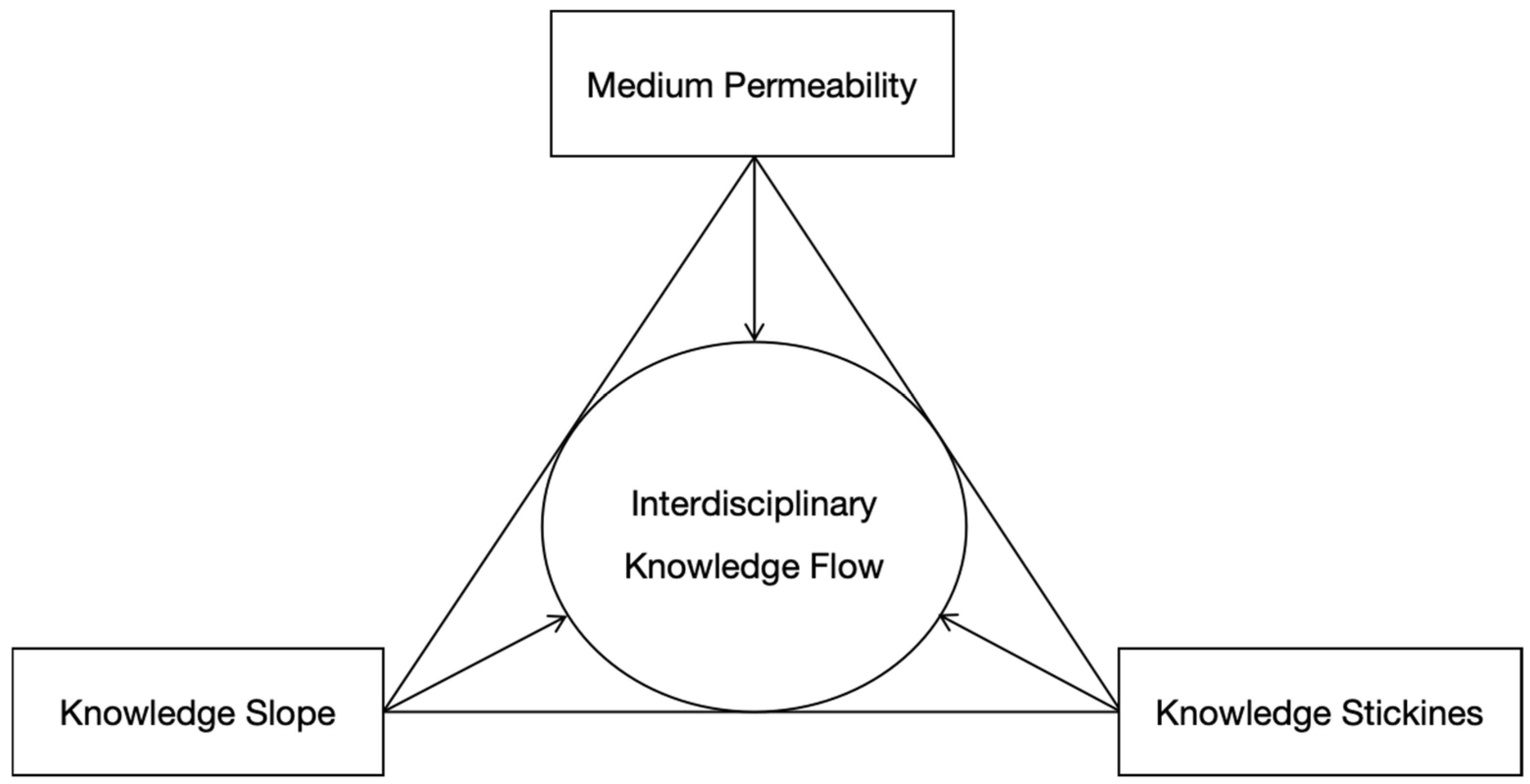
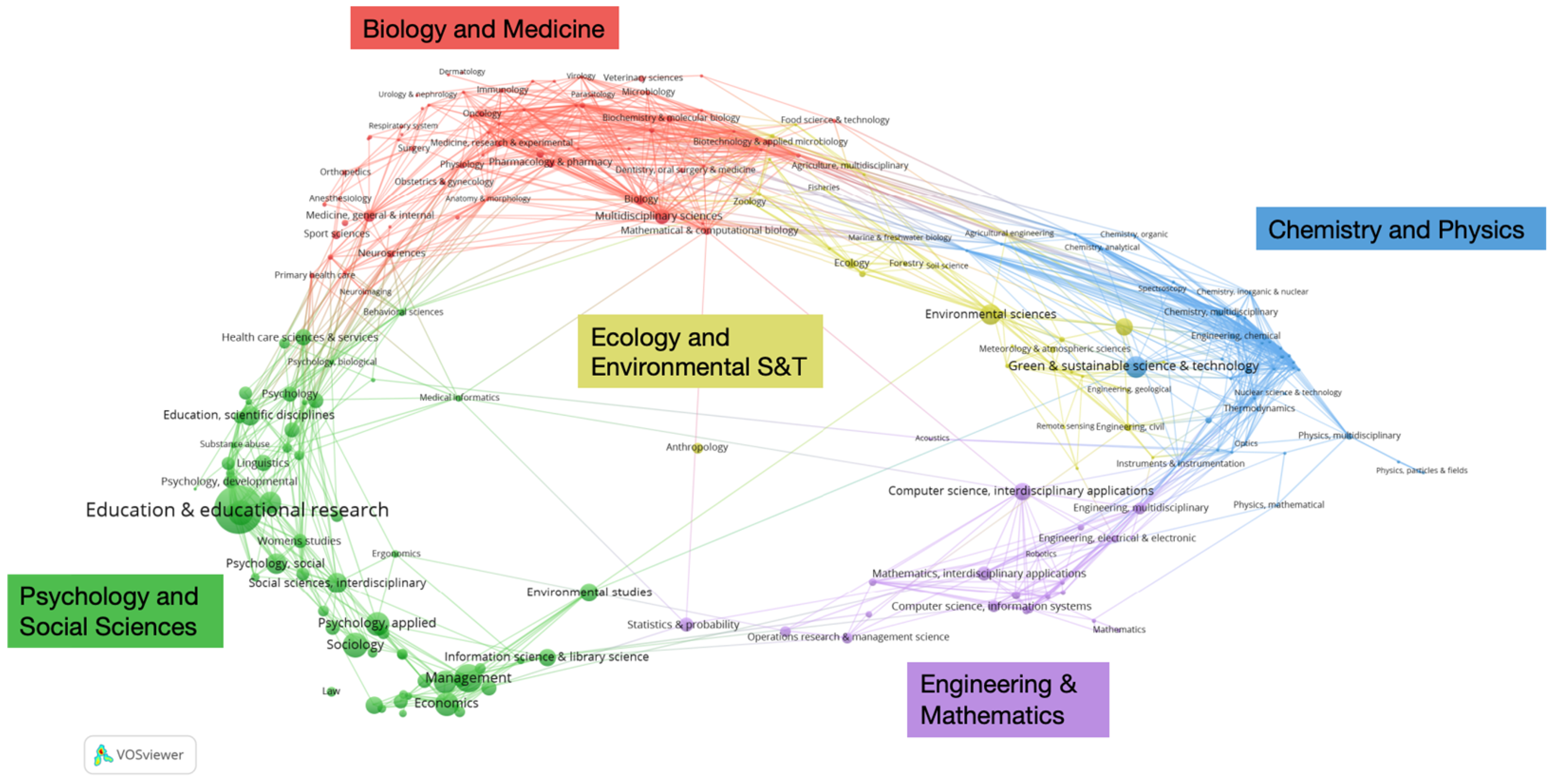
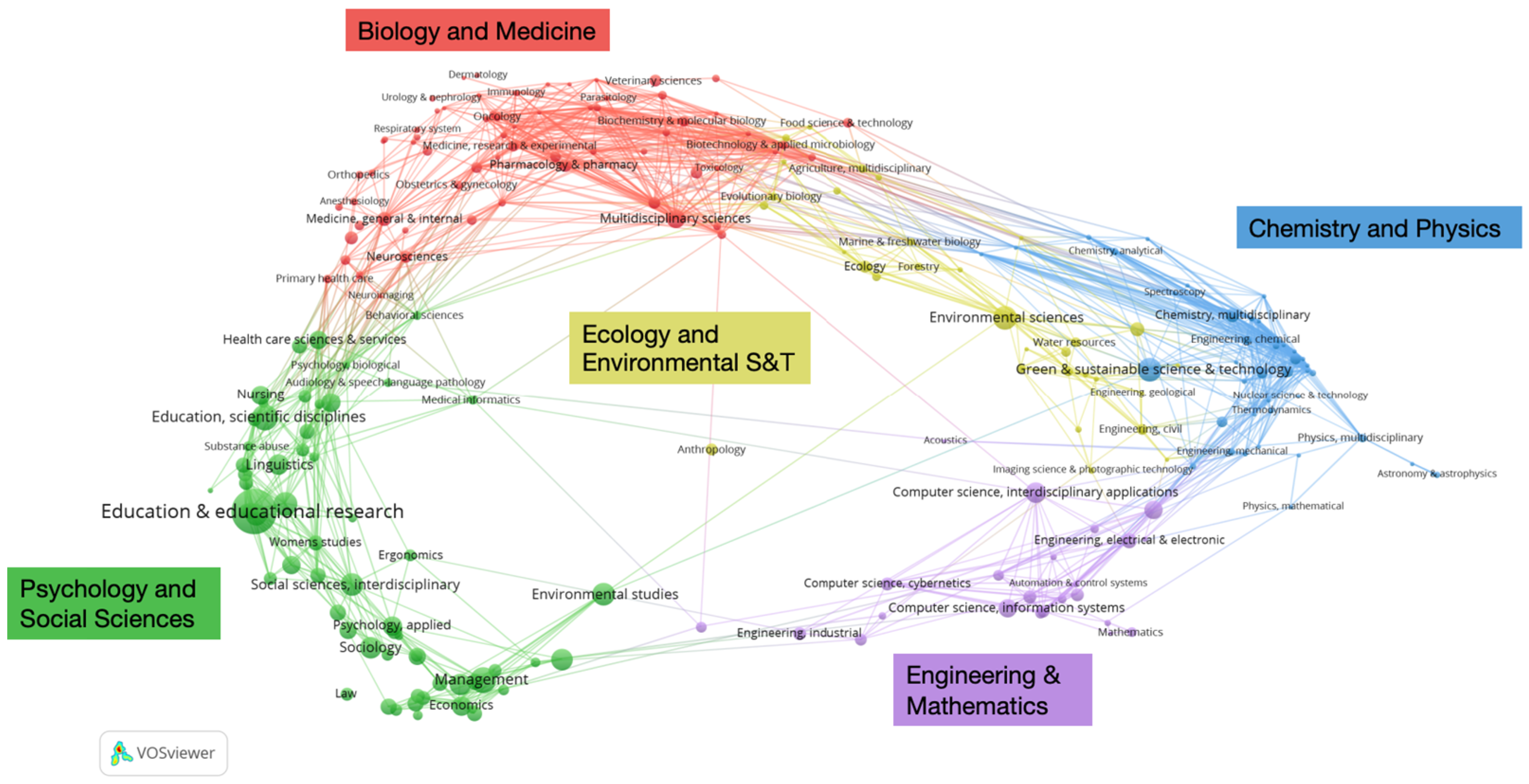
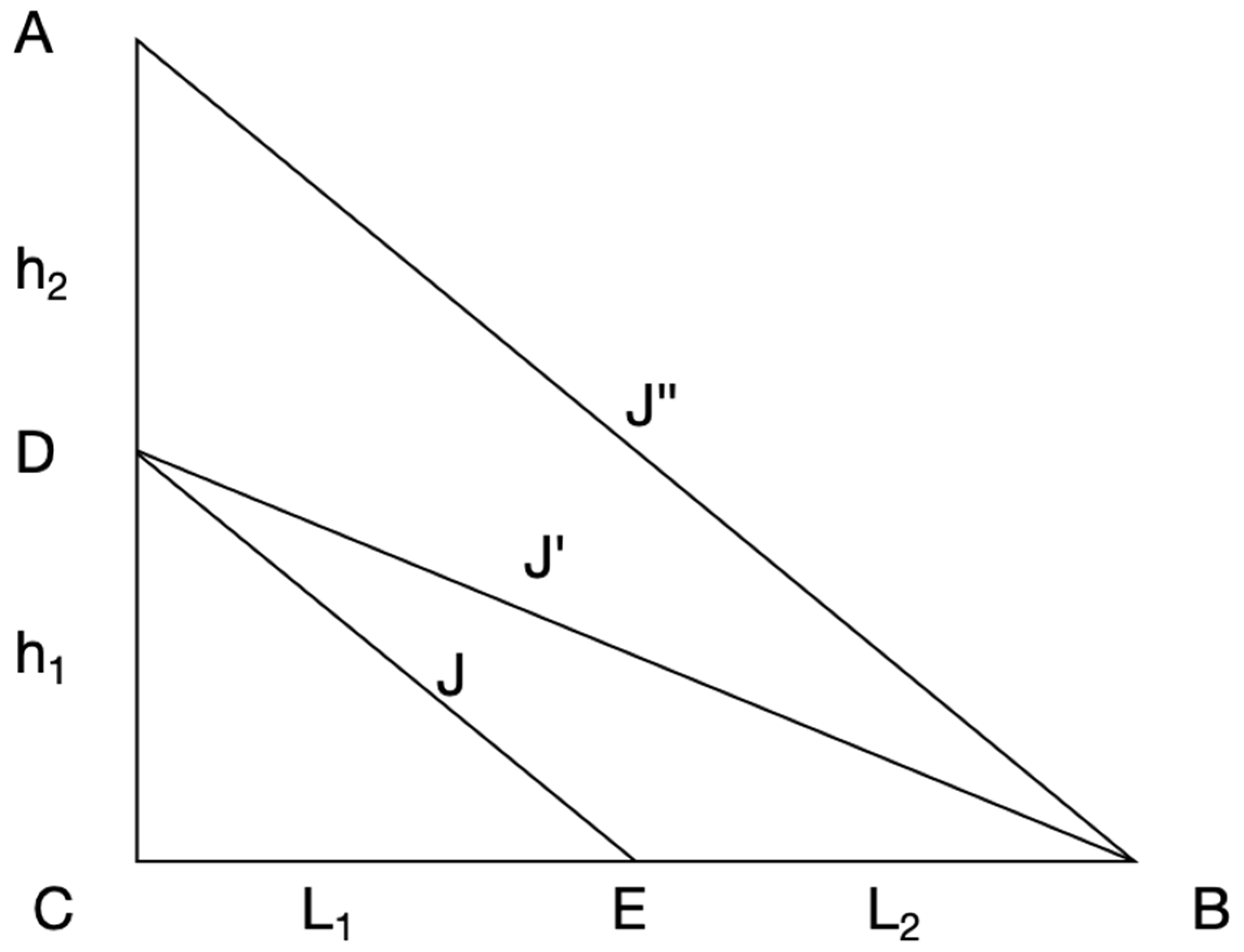
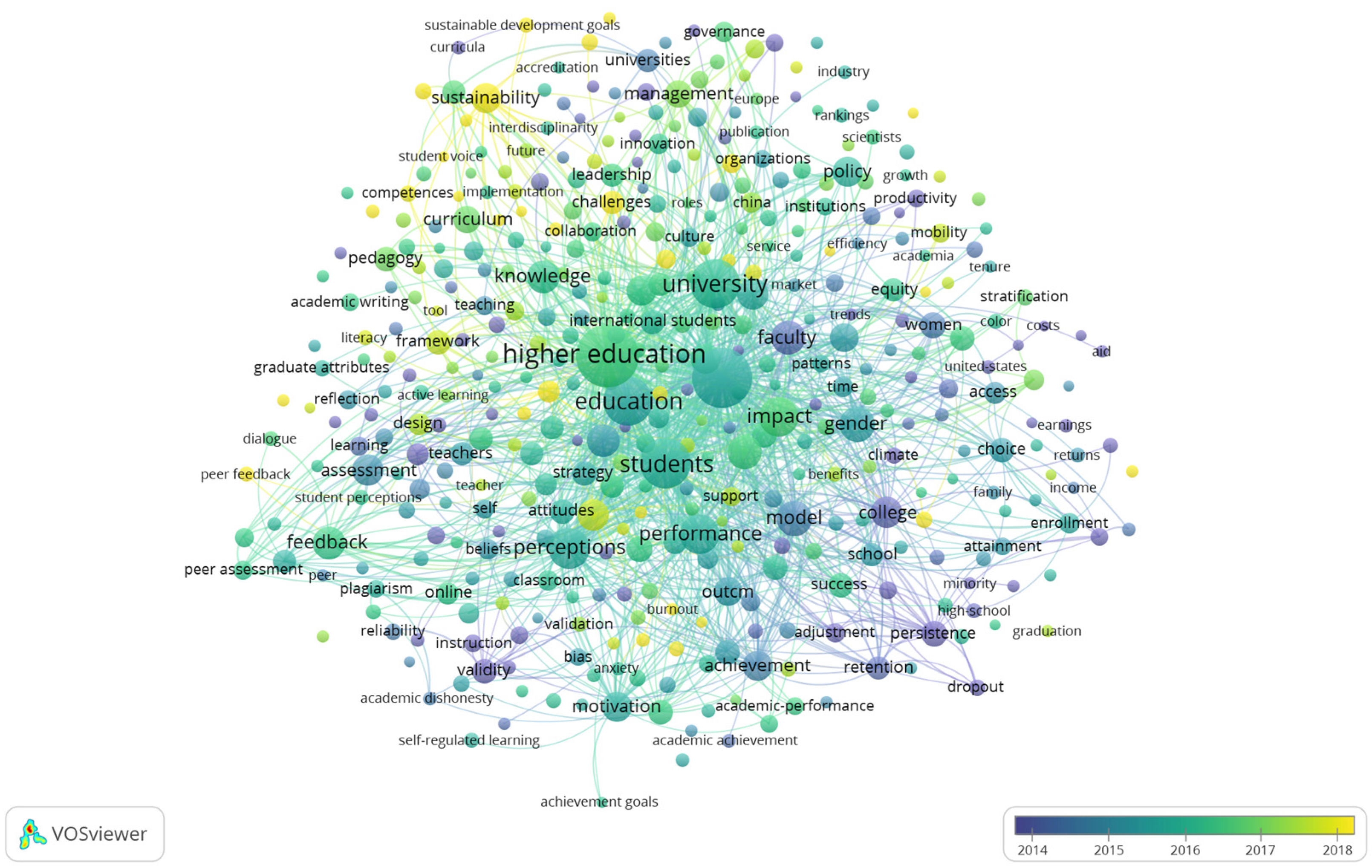
| Knowledge Absorption | Knowledge Diffusion |
|---|---|
| Acoustics | Materials Science Paper Wood |
| Anatomy Morphology | Medieval Renaissance Studies |
| Materials Science, Characterization and Testing | Polymer Science |
| Materials Science, Coatings and Films | Allergy |
| Meteorology Atmospheric Sciences | Engineering Petroleum |
| Mineralogy | Mycology |
| Ornithology | Physics Nuclear |
| Quantum Science and Technology | Quantum Science Technology |
| WOS Category | N | 302,111 |
|---|---|---|
| Eduation and Educational Research | 114,115 | 37.77% |
| Management | 16,201 | 5.36% |
| Sociology | 11,378 | 3.77% |
| Psychology, Educational | 111,213 | 3.71% |
| Economics | 10,364 | 3.43% |
| Psychology, Applied | 9560 | 3.16% |
| Business | 8970 | 2.97 |
| Psychology, Multidisciplinary | 7581 | 2.51% |
| Green and Sustainable Science and Technology | 7330 | 2.43% |
| Psychology, Social | 5987 | 1.98% |
| Environmental Sciences | 5633 | 1.86% |
| Social Sciences, Interdisciplinary | 5528 | 1.83% |
| Education, Scientific Disciplines | 5005 | 1.66% |
| Environmental Studies | 3880 | 1.28% |
| Information Science and Library Science | 3332 | 1.10% |
| Political Science | 3271 | 1.08% |
| Computer Science, Interdisciplinary Applications | 3168 | 1.05% |
| Engineering, Environmental | 3112 | 1.03% |
| Health Care Sciences and Services | 2827 | 0.94% |
| Linguistics | 2740 | 0.91% |
| Social Sciences, Mathematical Methods | 2299 | 0.76% |
| Multidisciplinary Sciences | 2058 | 0.68% |
| Public, Environmental and Occupational Health | 2016 | 0.67% |
| Psychology | 2010 | 0.67% |
| Psychology, Experimental | 1955 | 0.65% |
| Communication | 1872 | 0.62% |
| Geography | 1790 | 0.59% |
| Statistics and Probability | 1726 | 0.57% |
| Industrial Relations and Labor | 1708 | 0.57% |
| Public Administration | 1654 | 0.55% |
| WOS Category | N | 124,536 |
|---|---|---|
| Education and Educational Research | 67,495 | 22.42% |
| Education Scientific Disciplines | 7108 | 2.36% |
| Management | 6142 | 2.04% |
| Green Sustainable Science Technology | 4661 | 1.55% |
| Environmental Sciences | 4361 | 1.45% |
| Psychology Multidisciplinary | 4204 | 1.40% |
| Social Sciences Interdisciplinary | 3861 | 1.28% |
| Environmental Studies | 3766 | 1.25% |
| Psychology Educational | 3465 | 1.15% |
| Sociology | 3311 | 1.10% |
| Business | 3228 | 1.07% |
| Information Science Library Science | 3175 | 1.05% |
| Linguistics | 2868 | 0.95% |
| Computer Science Interdisciplinary Applications | 2521 | 0.84% |
| Economics | 2294 | 0.76% |
| Psychology Applied | 2280 | 0.76% |
| Public Environmental Occupational Health | 2090 | 0.69% |
| Language Linguistics | 2047 | 0.68% |
| Nursing | 1893 | 0.63% |
| Psychology Social | 1583 | 0.53% |
| Engineering Multidisciplinary | 1540 | 0.51% |
| Health Care Sciences Services | 1536 | 0.51% |
| Multidisciplinary Sciences | 1512 | 0.50% |
| Computer Science Information Systems | 1449 | 0.48% |
| Communication | 1228 | 0.41% |
| Hospitality Leisure Sport Tourism | 1202 | 0.40% |
| Geography | 1153 | 0.38% |
| Political Science | 1123 | 0.38% |
| Public Administration | 1036 | 0.34% |
| Social Work | 935 | 0.31% |
Disclaimer/Publisher’s Note: The statements, opinions and data contained in all publications are solely those of the individual author(s) and contributor(s) and not of MDPI and/or the editor(s). MDPI and/or the editor(s) disclaim responsibility for any injury to people or property resulting from any ideas, methods, instructions or products referred to in the content. |
© 2025 by the authors. Licensee MDPI, Basel, Switzerland. This article is an open access article distributed under the terms and conditions of the Creative Commons Attribution (CC BY) license (https://creativecommons.org/licenses/by/4.0/).
Share and Cite
Jia, W.; Pan, L.; Neary, S.; Moore, N. Interdisciplinary Knowledge Flow in International Higher Education Research: Characteristics and Mechanisms. Educ. Sci. 2025, 15, 221. https://doi.org/10.3390/educsci15020221
Jia W, Pan L, Neary S, Moore N. Interdisciplinary Knowledge Flow in International Higher Education Research: Characteristics and Mechanisms. Education Sciences. 2025; 15(2):221. https://doi.org/10.3390/educsci15020221
Chicago/Turabian StyleJia, Wenxiu, Li Pan, Siobhan Neary, and Nicki Moore. 2025. "Interdisciplinary Knowledge Flow in International Higher Education Research: Characteristics and Mechanisms" Education Sciences 15, no. 2: 221. https://doi.org/10.3390/educsci15020221
APA StyleJia, W., Pan, L., Neary, S., & Moore, N. (2025). Interdisciplinary Knowledge Flow in International Higher Education Research: Characteristics and Mechanisms. Education Sciences, 15(2), 221. https://doi.org/10.3390/educsci15020221





